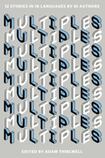
The problem of Constance Garnett and the Russian novelists is perhaps the best-known example of the challenges posed by translating an artist’s works from one language into another. It was in Garnett’s translations that generations of English readers came to know and love Tolstoy, Dostoevsky, Turgenev et al. There can be no doubt that she gave the world wonderful renderings, so much so that her fluent elegiac voice, deliciously tinged with melancholy, remains for many the essential voice of Russia. But Russians don’t necessarily agree. Joseph Brodsky said she makes all the Russian writers sound the same, because we aren’t really reading them, we’re reading Constance Garnett. And when you turn to more recent translations you see he must be at least partly right.
This is the kind of problem, among others, that the editor of Multiples, Adam Thirlwell, sets out to illustrate in this fascinating literary experiment. When we read a translated novel or any artistic piece we like to believe it's a kind of facsimile of the original. And most of the time, having little or no knowledge of the language the original was written in, we have to believe it. Multiples is an exercise in showing us how wrong we can be.
It was clearly not easy to do. Administratively it must have been a nightmare. Thirlwell found 12 stories that had not already been translated into what has become the universal lingua franca, English. Then he asked 61 international authors to translate a story into their own language. Thus a story would be translated several times over. First into English by an Anglophone, then into French or Urdu or Italian – 18 languages are represented – then back into English by another Anglophone . . . Which would be retranslated, say, into Spanish and then into English again. Yes, the process is almost as dizzying to read as it is to read about. However, the fun in comparing the first translated version with the last is considerable, if a little nerdy.
Modernist tone
As Thirlwell says in his ebullient preface, the result is a book in the manner of one of those modernist publications that had texts in several languages. And its tone is modernist, in that many of the stories he has chosen were written in the early to mid 20th century or even, in the case of Kirkegaard, well before, and have the unconventional and often fragmentary style of the period. A few seem to be unpublished even in their own languages.
There are some great finds among them. The Italian Giuseppe Pontiggia's Incontrarsi, about a man who lives his life as an act of opposition to his father, stands out for its style of sophisticated clarity. But is this actually Pontiggia's style? Or is it that of the talented Zadie Smith, who makes the first translation?
That Smith may be taking liberties is perhaps suggested by her translation of the title as Umberto Buti, the protagonist's putative name. A baffling decision when I – even with my limited Italian – would regard a straight interpretation of the title Pontiggia gave it, Incontrarsi, to be more illuminating. Then, by the time Tash Aw has his way with it via the Chinese of Ma Jian, the protagonist has become Tian Huaiyi, whose life is passed in China, and the story has a sanitised Chinese flavour and isn't half as impressive.
You feel something akin to betrayal when this kind of thing happens, and it happens a lot. Which makes you realise how much trust we place in translators but how in reality we are helpless in their hands.
Very soon one even begins to distrust the “original”, which is to say the first, translation. Because the true original isn’t provided – it’s unlikely, after all, that one would have the competence to read it – this first translation takes its place, the template from which the rest are seen as deviations.
Most of the time this seems justified. When Colm Tóibín translates Los de Abajo into English from the Spanish of Javier Marías (complicated: this is a story by the now unknown English writer Richard Middleton that Marías translated years ago), and being aware that Tóibín knows Spanish as a second language, we assume – we want to assume – his limpid graceful style is Middleton's own. But might Tom McCarthy's more brusque version, the sixth and last of its devolutions, be actually more faithful? Maybe in this case we could also have been given the original.
Some contributors are outrageously profligate with the concept of fidelity. Sheila Heti writes a character she calls Nancy into Kirkegaard's story. Referring back to the French translation that went before you see that Heti, who states gaily that her French is rudimentary, decided to make the conjunction "ainsi" into "Nancy", possibly for her own amusement. But then she, like the other translators, was encouraged by the mischievous Thirlwell to let go, to not be scrupulous. Some of them may have felt it as an obligation. They felt free not to google or to even consult a dictionary.
Of course any author disquieted by this book can be sure that “real” translators of their work are diligent and conscientious and sensitive people, overseen by equally sober editors, who all know their own and your language inside out. Er . . . Right?
Anne Haverty's latest novel is The Free and Easy.









